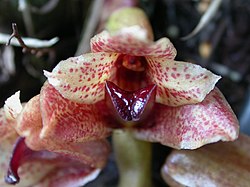| Xylobium | |
|---|---|
 | |
| Xylobium colleyi | |
| Scientific classification | |
| Kingdom: | Plantae |
| Clade: | Tracheophytes |
| Clade: | Angiosperms |
| Clade: | Monocots |
| Order: | Asparagales |
| Family: | Orchidaceae |
| Subfamily: | Epidendroideae |
| Tribe: | Cymbidieae |
| Subtribe: | Maxillariinae |
| Genus: | Xylobium Lindl. (1825) |
| Type species | |
| Xylobium squalens (Lindl.) Lindl. | |
| Selected species | |
| |
| Synonyms [1] | |
Xylobium, abbreviated Xyl in horticultural trade, is a genus of plants in family Orchidaceae. It contains about 35 species native to tropical America. [2]